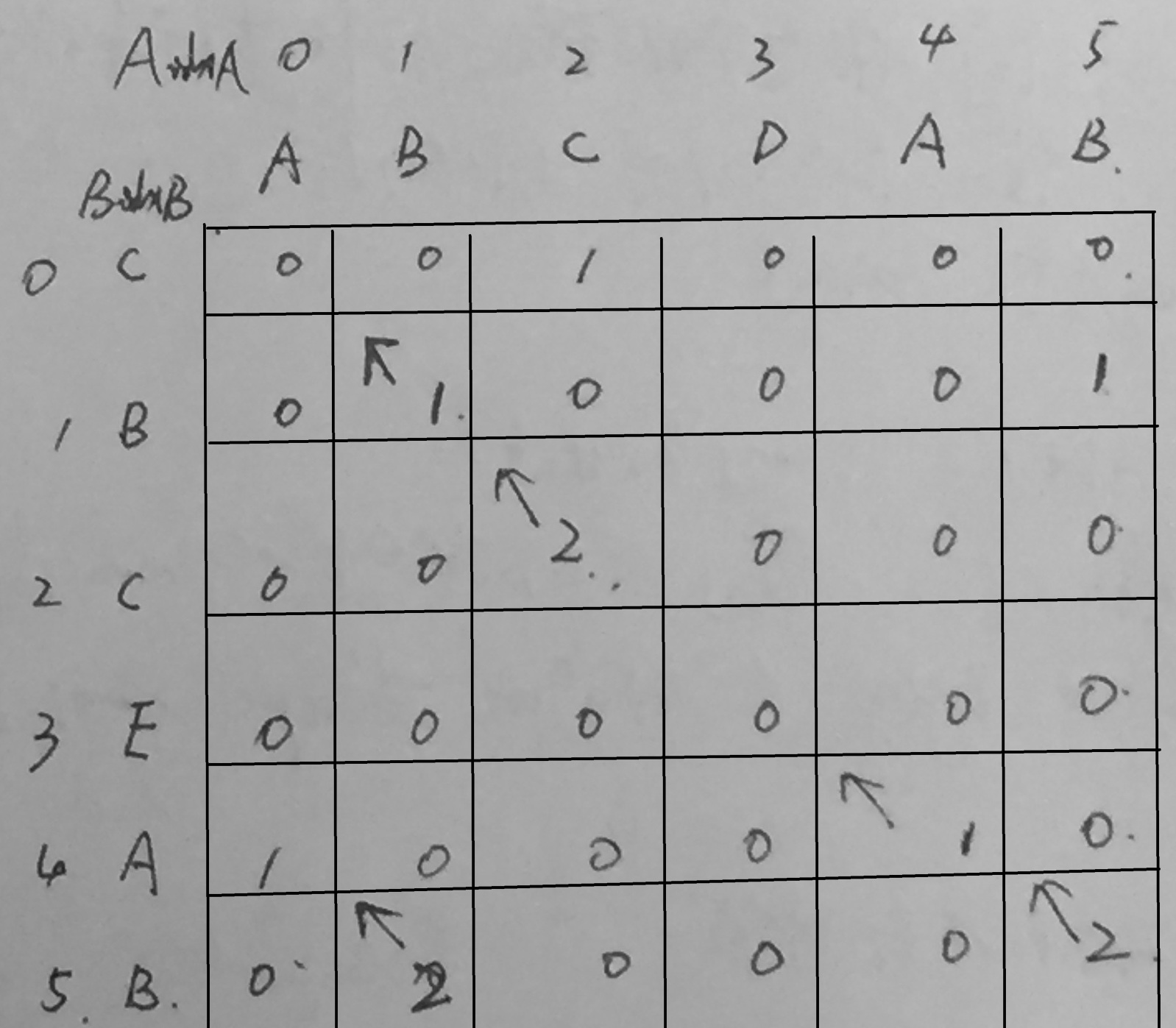子序列和子字符串的不同之处在于,子序列不需要是原序列上连续的字符。对于 Longest Common Substring 以及 Longest Common Subsequence 这类题目,大多数需要用到 DP 的思想,其中,状态转移是关键。
最长公共子字符串
Given two strings, find the longest common substring.
Return the length of it.
- Example
Given A = “ABCD”, B = “CBCE”, return 2.
- $L(idxA, idxB)$:以 $A[idxA]$ 和 $B[idxB]$ 结尾的相同子字符串的最长长度。最长公共子字符串必然存在所有情况中以 A 序列中某个字符结尾,以 B 序列中某个字符结尾的一种情况,所以取所有可能情况中的最大值即为 Longest Common Substring 的长度。
- 因为要求子串连续,所以对于 $A_{idxA}$ 与 $B_{idxB}$ 来讲,它们要么与之前的公共子串构成新的公共子串;要么就是不构成公共子串。
$$ L(idxA, idxB) = \begin{cases}
if(idxA==0||idxB==0): \begin{cases} 1, A[idxA]==B[idxB] \cr 0, others \end{cases} \cr
else-if(A[idxA]==B[idxB]): L(idxA-1, idxB-1) + 1 \cr
else: 0
\end{cases}
$$ - 上述过程的示例图如下,可以看出只有对角线方向上的长度延伸,长度不能保留。

1
2
3
4
5
6
7
8
9
10
11
12
13
14
15
16
17
18
19
20
21
22
23
24
25
26
27
28
29
30
31
32
33
34
35
36
37
38
39
40class Solution {
public:
/**
* @param A, B: Two string.
* @return: the length of the longest common substring.
*/
int longestCommonSubstring(string &A, string &B) {
int lenA = A.length();
int lenB = B.length();
if(lenA==0 || lenB==0) {
return 0;
}
// L[idxA][idxB]: the largest length of LCS ending with A[idxA] and B[idxB]
int L[lenA][lenB];
for(int idxB=0; idxB<lenB; idxB++) {
L[0][idxB] = B[idxB]==A[0]? 1 : 0;
}
for(int idxA=0; idxA<lenA; idxA++) {
L[idxA][0] = A[idxA]==B[0]? 1 : 0;
}
for(int idxA=1; idxA<lenA; idxA++){
for(int idxB=1; idxB<lenB; idxB++){
L[idxA][idxB] = A[idxA]==B[idxB]? L[idxA-1][idxB-1]+1 : 0;
}
}
int maxLen = 0;
int maxLenIdx = -1;
for(int idxA=0; idxA<lenA; idxA++){
for(int idxB=0; idxB<lenB; idxB++){
if(L[idxA][idxB] > maxLen) {
maxLen = L[idxA][idxB];
maxLenIdx = idxA;
}
}
}
return maxLen;
}
};
- 因为要求子串连续,所以对于 $A_{idxA}$ 与 $B_{idxB}$ 来讲,它们要么与之前的公共子串构成新的公共子串;要么就是不构成公共子串。
- 提取最长公共子串
- 使用变量
maxLenIdx记录最长公共子串(长度maxLen)对应的结尾字符下标(序列 A/B 都可以),回退获取maxLen个字符即可。
- 使用变量
最长公共子序列
Given two strings, find the longest common subsequence (LCS).
Your code should return the length of LCS.
- Example
For “ABCD” and “EDCA”, the LCS is “A” (or “D”, “C”), return 1.
For “ABCD” and “EACB”, the LCS is “AC”, return 2.
- $L(idxA, idxB)$:以 $A_{idxA}$ 结尾的子串($A[0, 1, …, idxA], 0 \leq idxA \lt len_A$) 和 $B_{idxB}$ 结尾的子串($B[0, 1, …, idxB], 0 \leq idxB \lt len_B$)最长公共子序列的长度。自然地,$L(len_A-1, len_B-1)$ 即为所求的最长公共子序列长度。
- 与子串不同,子序列可以是不连续的。
- $L(idxA, idxB)$ 与 $L(idxA-1, idxB-1)$ 两者其实只差 $A_{idxA}$ 和 $B_{idxB}$ 这一对字符。
- 如果 $A_{idxA}$ 和 $B_{idxB}$ 相同,那么就只要在以 $A_{idxA}$ 和以 $B_{idxB}$ 结尾的两个子串的最长公共子序列之后添上这个相同字符即可,这样就可以让长度增加一位。
- 如果 $A_{idxA}$ 和 $B_{idxB}$ 不同,两个子串在末尾添加一个字符后最长公共子序列并不能得到延伸。考虑到 $A_{idxA}$ 可能与 $B_{idxB-1}$ 相同或者 $B_{idxB}$ 会与 $A_{idxA-1}$ 相同,没能延伸的最长公共子序列只能在 $L(idxA, idxB-1)$ 和 $L(idxA-1, idxB)$ 存在,取更长的那个。
- 结合边界限制,最终得到的状态转移方程如下:
$$ L(idxA, idxB) = \begin{cases}
if(idxA==0): \begin{cases} 1, B[idxB]==A[0] \cr L(0, idxB-1), others \end{cases} \cr
else·if(idxB==0): \begin{cases} 1, A[idxA]==B[0] \cr L(idxA-1, 0), others \end{cases} \cr
else·if(A[idxA]==B[idxB]): L(idxA-1, idxB-1) + 1 \cr
else: max(L(idxA, idxB-1), L(idxA-1, idxB))
\end{cases}
$$ - 上述过程的示例图如下,可以看出同样只有对角线方向上的长度延伸,不过长度可以在 上→下 和 左→右 方向上得到保留。

1
2
3
4
5
6
7
8
9
10
11
12
13
14
15
16
17
18
19
20
21
22
23
24
25
26
27
28
29
30
31
32
33
34
35
36
37
38
39
40
41
42
43
44
45
46
47
48
49
50
51
52
53
54
55
56
57
58
class Solution {
public:
/**
* @param A, B: Two strings.
* @return: The length of longest common subsequence of A and B.
*/
int longestCommonSubsequence(string A, string B) {
int lenA = A.length();
int lenB = B.length();
if(lenA==0 || lenB==0) {
return 0;
}
// L[idxA][idxB]: the length of the LCS ending with A[idxA] and B[idxB]
int L[lenA][lenB];
// for recording LCS's tail element index
int maxLen = 0, maxLenIdxA = 0, maxLenIdxB = 0;
L[0][0] = A[0]==B[0]? 1 : 0;
for(int idxB=1; idxB<lenB; idxB++) {
L[0][idxB] = B[idxB]==A[0]? 1 : L[0][idxB-1];
// for recording LCS's tail element index
if(L[0][idxB] > maxLen) {
maxLen = L[0][idxB];
maxLenIdxB = idxB;
}
}
for(int idxA=1; idxA<lenA; idxA++) {
L[idxA][0] = A[idxA]==B[0]? 1 : L[idxA-1][0];
// for recording LCS's tail element index
if(L[idxA][0] > maxLen) {
maxLen = L[idxA][0];
maxLenIdxA = idxA;
}
}
for(int idxA=1; idxA<lenA; idxA++) {
for(int idxB=1; idxB<lenB; idxB++) {
if(A[idxA] == B[idxB]) {
L[idxA][idxB] = L[idxA-1][idxB-1] + 1;
}
else {
L[idxA][idxB] = max(L[idxA][idxB-1], L[idxA-1][idxB]);
}
// for recording LCS's tail element index
if(L[idxA][idxB] > maxLen) {
maxLen = L[idxA][idxB];
maxLenIdxA = idxA;
maxLenIdxB = idxB;
}
}
}
return L[lenA-1][lenB-1];
}
};
- 提取最长公共子序列
- 使用变量
maxLen记录最长公共子序列的长度,并通过变量maxLenIdxA和maxLenIdxB记录该最长长度序列末尾字符对应的序列 A 和序列 B 中的字符下标。 - 在序列 A 和 B 中分别从下标
maxLenIdxA和maxLenIdxB向左挪动,找出maxLen个相同字符,即为提取的最长公共子序列。 - 如何在序列 A 和 B 中向左挪动呢?
A[maxLenIdxA]==B[maxLenIdxB],当前字符相同,同时左挪(因为公共子序列的特点,此时二者肯定均为到达边界):maxLenIdxA--&maxLenIdxB--。A[maxLenIdxA]!=B[maxLenIdxB],当前字符不相同- 有挪动到边界(0)的,只能挪动另一个还没到边界的;假如同时挪动到边界,由于
maxLen的准确性,说明已经提取出最长公共子序列。 L[idxA][idxB-1]大,说明A[maxLenIdxA]可能与序列 B 中下一个字符相同,需要挪动序列 B:maxLenIdxB--;反之,则需要挪动序列 A:maxLenIdxA--。
- 有挪动到边界(0)的,只能挪动另一个还没到边界的;假如同时挪动到边界,由于
- 具体的代码实现如下:
1
2
3
4
5
6
7
8
9
10
11
12
13
14
15
16
17
18
19
20
21
22
23
24string LCS;
while(maxLenIdxA>=0 && maxLenIdxB>=0) {
if(A[maxLenIdxA] == B[maxLenIdxB]) {
LCS += A[maxLenIdxA];
maxLenIdxA--;
maxLenIdxB--;
}
else {
if(maxLenIdxA == 0) {
maxLenIdxB--;
}
else if(maxLenIdxB == 0) {
maxLenIdxA--;
}
else {
if(L[maxLenIdxA][maxLenIdxB-1] < L[maxLenIdxA-1][maxLenIdxB]) {
maxLenIdxB--;
}
else {
maxLenIdxA--;
}
}
}
}
- 使用变量